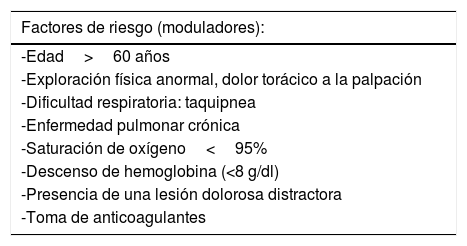Se considera un traumatismo leve-moderado aquel que se encuentra fuera del contexto de politraumatismo, no presenta un mecanismo de alta energía, no es penetrante y se acompaña de contusión de la pared torácica o de fracturas costales sin asociar una lesión torácica que amenace de forma inmediata la vida del paciente. Es un motivo de consulta frecuente en los servicios de urgencias. La radiología convencional de tórax y la tomografía computarizada (TC) son las técnicas diagnósticas radiológicas realizadas habitualmente, considerándose la TC torácica como el estándar de referencia diagnóstico. Sin embargo, no existen guías clínico-radiológicas de actuación actualizadas que establezcan indicaciones de cuándo hay que solicitar una TC en este motivo de consulta. Por ello buscamos las recomendaciones basadas en la evidencia para mejorar la adecuación de la solicitud de pruebas radiológicas urgentes con el objetivo de disminuir costes y evitar radiación innecesaria.
Mild-moderate blunt chest trauma is defined as a blunt chest trauma that is not caused by a high-energy mechanism, causing thoracic tenderness with or without rib fractures and that has no immediate life-threatening consequences for the patient. It is a frequent clinical situation in the emergency department. The most common radiological techniques that are used in this context are chest X-ray and thoracic computed tomography (CT). The CT scan is set as the gold standard. However, there are no current clinical-radiological guidelines that establish the adequacy of the requests of the CT scan. Therefore, we decided to search for evidence-based recommendations to improve the adequacy of the chest X-ray and CT scan in our daily practice in order to reduce the costs and avoid unnecessary radiation exposure.
Artículo
Comprando el artículo el PDF del mismo podrá ser descargado
Precio 19,34 €
Comprar ahora










